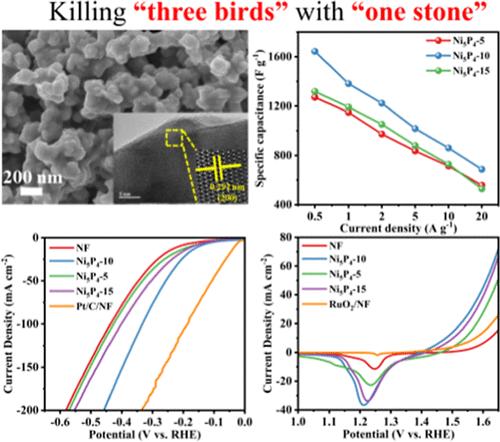基于微乳液策略的mof衍生Ni5P4纳米粒子超级电容器和水分解
IF 4.7
2区 化学
Q1 CHEMISTRY, INORGANIC & NUCLEAR
引用次数: 0
摘要
随着储能和转换系统(ESCSs)的快速发展,可再生能源可以实现平稳和连续的输出能力。然而,基于贵金属的商用多功能ESCSs材料存在着稀缺性和高生产成本等问题。本研究采用微乳液和化学气相沉积(CVD)技术成功制备了单晶Ni5P4纳米颗粒。单晶Ni5P4由于其优异的晶体完整性和高导电性,为氧化还原反应提供了丰富的活性位点。此外,它允许电子和离子更有效和自由地移动,使其成为一种非常有前途的escs多功能材料。对于超级电容器(SCs),制备的Ni5P4-10电极具有类似电池的性能,具有1643.13 F g - 1@0.5 a g -1的高比容量。在400 W kg-1的功率密度下,组装的Ni5P4-10//AC杂化SCs (hsc)的最大能量密度为37.78 Wh kg-1。此外,Ni5P4-10作为电催化剂时,在10 mA cm-2下的过电位为150 mV@HER和250 mV@OER。该研究为mof衍生的多功能ESCSs材料的设计提供了新的视角。本文章由计算机程序翻译,如有差异,请以英文原文为准。

MOF-Derived Ni5P4 Nanoparticles Based on the Microemulsion Strategy for Supercapacitors and Water Splitting
With the rapid advancement of energy storage and conversion systems (ESCSs), renewable energy can achieve a smooth and continuous output capacity. Nevertheless, commercial precious metal-based multifunctional ESCSs materials are plagued by issues like scarcity and high production costs. This study adopted microemulsion and chemical vapor deposition (CVD) strategies to fabricate single crystal Ni5P4 nanoparticles successfully. Due to its excellent crystal integrity and high electrical conductivity, single crystal Ni5P4 offers abundant active sites for redox reactions. Additionally, it allows electrons and ions to move more efficiently and freely, making it a highly promising multifunctional material for ESCSs. For supercapacitors (SCs), the prepared Ni5P4-10 electrode possesses a battery-like behavior with a high specific capacity of 1643.13 F g–1@0.5 A g–1. The corresponding assembled Ni5P4-10//AC hybrid SCs (HSCs) exhibit a maximum energy density of 37.78 Wh kg–1 at a power density of 400 W kg–1. Furthermore, Ni5P4-10 displays low overpotentials of 150 mV@HER and 250 mV@OER at 10 mA cm–2 when it serves as an electrocatalyst. This study offers a novel perspective for the design of MOF-derived multifunctional ESCSs materials.
求助全文
通过发布文献求助,成功后即可免费获取论文全文。
去求助
来源期刊

Inorganic Chemistry
化学-无机化学与核化学
CiteScore
7.60
自引率
13.00%
发文量
1960
审稿时长
1.9 months
期刊介绍:
Inorganic Chemistry publishes fundamental studies in all phases of inorganic chemistry. Coverage includes experimental and theoretical reports on quantitative studies of structure and thermodynamics, kinetics, mechanisms of inorganic reactions, bioinorganic chemistry, and relevant aspects of organometallic chemistry, solid-state phenomena, and chemical bonding theory. Emphasis is placed on the synthesis, structure, thermodynamics, reactivity, spectroscopy, and bonding properties of significant new and known compounds.
 求助内容:
求助内容: 应助结果提醒方式:
应助结果提醒方式:


